One of the most energy consuming processes affecting your shipping container home energy usage is the transfer of heat into and out of the building. Sometimes you want to purposefully move heat, and sometimes you want to slow its movement. Both cases are important and deserve your attention and planning when designing and building a shipping container home or building.
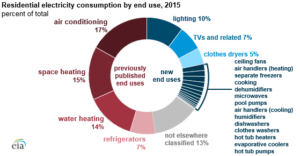
Have you ever touched a hot stove, used a hair dryer, or felt the heat of a bonfire on a cold night If so, you have an intuitive sense of heat transfer. In this article, we’re going to discuss the physics behind heat transfer and its important implications for shipping container homes.
While heat transfer itself is a bit technical, we believe it is crucial for you to have an understanding of how it works. The movement of heat directly impacts decisions that cost thousands of dollars and affect your overall livability and comfort in your container home. We’ve cut through the non-relevant details and provided clear examples to help you navigate some of these important decisions.
What exactly is “heat”?
Before you understand heat transfer, you need to understand heat. Heat is a form of energy associated with thermal or temperature changes. It always flows from the hotter object to the cooler one, unless acted on by an outside force (like an air conditioner).
It’s important to understand that you cannot add coldness to something; you can only take away heat. Cold, therefore, is the absence of heat. An air conditioner isn’t adding coolness to your house, it is taking the heat from your house and moving it outside (even though it is hotter outside than in). It’s similar to how you cannot add darkness to a room, you can only take away light.
The three types of heat transfer
Heat energy is transferred in three primary ways, each of which is important to understand in the context of shipping container structures.
Conduction
Conduction, the simplest form of heat transfer, is how heat moves within a single solid object and also between solid objects in direct contact.
When you touch a hot stove, the heat from the burner is transferred to your hand. If you hold a metal spoon in your hand and touch the spoon to the burner, your hand will eventually get hot because the heat conducts through the spoon. However, if you wear an oven mitt (insulation), much less of that heat energy will make it to your hand.
In a container, the exterior corrugated metal is usually the hottest (in the summer) or coldest (during the winter) part of the building, as it is closest to the outside environment. Anything touching this outer layer of metal, like the insulation, wall studs, windows, door frames, etc., will also have this heat transmitted to it via conduction. Conduction is where the concept of thermal bridging comes into play.
Thermal Bridging
Thermal bridging takes place when a section of a wall system has a higher conductivity (or, lower insulative capacity) than the surrounding material. This creates a ‘path of least resistance’ for conductive heat flow. This, in turn, lowers the overall insulative capacity of the entire wall system.
For instance, if you use metal wall studs that attach to the inside of the container and have direct metal-to-metal contact, heat will conduct from the exterior metal into the studs. With wooden studs, the same thing occurs, except that wood is much less effective as a conductor. Therefore, less heat will migrate into the interior of your building. Another option is placing a more insulative material between the container’s corrugated metal and the metal wall studs. If you’re interested in knowing how well common building materials insulate, this is a great resource.
The key takeaway is that you want to separate the interior living space of your container from the exterior metal with as much insulation as possible. But remember that the insulation only works when it is between the inside wall and the exterior corrugated metal. Any material that thermally “bridges” this gap through or around the insulation is reducing the effect of your insulation, and you should take steps to minimize this as much as possible. Otherwise, your expensive insulation is somewhat wasted.
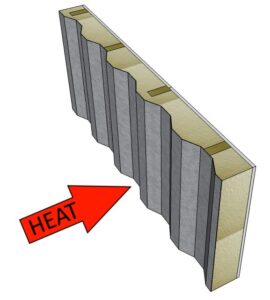
Convection
Convection is the second mode of heat transfer and can be generally defined as the transfer of heat between a solid and a fluid. Fluid is an engineering term that represents both liquids (like water) and gases (like air). There are actually two types of convection, with only a slight difference between them.
Natural Convection
A hot object exposed to a fluid naturally heats it up. Due to changes in density (and therefore buoyancy) that correlate with temperature increases, the hot fluid will naturally move away from the hot object in a convective current, with colder fluid taking its place. This leads to the common saying “heat rises”. If you’ve ever held your hand high above a stove burner and noticed the air is warmer than elsewhere in the room, you’ve experience natural convection.
Forced Convection
A hot object that has a fluid moved over it by an external force, like a fan or pump. If you’ve ever used a hairdryer, this is an example of forced convection, as an electric fan is forcing air over an electric heating element.
Convection in Shipping Containers
In the summer, the heat from your container roof increases the temperature of the air surrounding it via natural convection (We’ll explain later why the roof gets hot!). This hot air rises in a column above the container, continually being replaced by the slightly cooler ambient air in the atmosphere.
In traditional construction with peaked roofs, placing ridge vents at the top of the roof (and eave vents at the bottom) is a way to allow hot air to escape your attic via natural convection. Ideally, the temperature of your attic would be no higher than the ambient temperature outside the house, but without this ventilation, your attic turns into an oven.
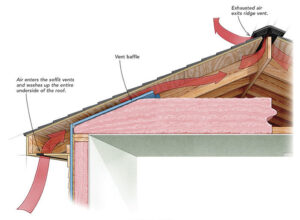
However, for container homes, this isn’t especially practical. Unless you add a peaked roof above the container, a container home won’t have an attic or airspace above the insulation in the roof.
Radiation
Radiation is the last of the three modes of heat transfer and is the most difficult to understand. The word radiation usually has a very negative connotation, so let’s first start by understanding what radiation is at a high level. Then, we’ll discuss the types of radiation that exist.
In simple terms, radiation is energy that is transmitted through matter via invisible waves. It can be broken into two types.
Ionizing radiation
The ‘bad’ radiation you hear about that can cause damage to living tissue. It’s the reason you wear a lead vest when getting an X-ray, and why humans can’t visit the site of the Chernobyl nuclear reactor accident in Ukraine.
Non-ionizing radiation
All other radiation on the electromagnetic spectrum. It includes visible light, radio waves, and many others. The thermal radiation we’re discussing here is a type of non-ionizing radiation.
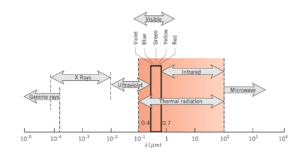
How thermal radiation is experienced
The majority of thermal radiation we encounter in everyday life is transmitted via the visible and infrared portions of the spectrum (The reasons why are beyond the scope of this article).
If you’ve stood around a bonfire and felt warm even though the air around you was cold, you’ve experienced thermal radiation. The burning wood was radiating thermal energy that was absorbed by your body, increasing the temperature of your skin.

Or think about a thermal camera that detects the thermal radiation emitted by various objects.

Thermal radiation is emitted from anything that has a temperature above absolute zero (the lowest temperature theoretically possible at -273.15°C or -459.67°F). In fact, your body is radiating a tiny amount of heat into the room around you now (This is in addition to the conduction into the chair you’re sitting in, and the convection into the room’s air).
If you are in a room with a glass of cold water, both you and the water are radiating heat energy toward each other. But because your body temperature is much warmer than the water, you are sending out much more energy than it is. From your perspective, you’re sending out a lot of heat energy, but only receiving a little, so your body temperature decreases. From the water’s perspective, it is sending out only a little thermal radiation, while receiving a lot from you, so its temperature increases. Eventually, given enough time, you would both arrive at the same equilibrium temperature.
Thermal Radiation for Shipping Containers
The most important source of thermal radiation for shipping container homes is the sun. The sun emits radiation at many different frequencies, much of which is blocked by our atmosphere. What’s left includes thermal energy, among others.
When a container is placed outside in the sun, the ambient air heats the exterior corrugated metal to the ambient temperature via convection. However, when the sun hits this outside metal of the container, thermal radiation causes the metal’s temperature to actually increase above the ambient air temperature. This increased heat energy is then transferred via conduction into the interior of the container through the studs, insulation, and other components of the wall. You cannot eliminate this conduction, but you can reduce it by using materials with low conductivity (and high insulating capacity), as we discussed in the section on conduction.
The best way to minimize heat gain from thermal radiation is not to insulate against it like with conduction and convection, but to block it (for example, with shade) or reflect it (with reflective coatings or materials) back into the atmosphere. Our article on cool roof coatings goes into more detail about dealing with the sun’s thermal energy, so definitely check it out (it includes a discussion on what to do when you’re in a cold environment and want to maximize how much thermal energy you absorb).
Thermal Radiation as a cooling mechanism
It’s important to note that thermal radiation isn’t only about making your container hotter. As mentioned previously, everything with a temperature above absolute zero is radiating heat, including your container. At night when the sun has set, the container continues to radiate energy out, just as it did in the day. But now that the sun is gone, much less heat is radiating into the container.
Under certain conditions (direct line of sight from the container to the sky, with a clear sky free of clouds, etc.), a container at night can actually radiate more energy out than it is receiving in, which is called passive radiative cooling or sky cooling. If these conditions persist for more than a few minutes, the temperature of the container can actually drop below that ambient temperature.
In the past few years, researchers have been working on special materials that are great at both reflecting thermal radiation and emitting their own heat as thermal radiation. In experiments, they’ve actually been able to lower the temperature of a material below ambient temperature while in direct sunlight. With additional refinement and research, one day we may be able to use special coatings that dramatically reduce cooling loads and reduce the need for air conditioning.
Why heat transfer matters for shipping container homes
Regardless of where you live, you want your shipping container home to be a comfortable space. That can include the way it looks, but more importantly, it means the way it feels with regard to temperature.
Unless you live in an extremely temperate climate where air conditioners and heaters are things you only see on television, you’re going to need to think about heating and cooling your container home. And anytime you try to make the inside of your container have a different temperature than the outside, you’re fighting a battle against physics and mother nature.
By understanding the principles of heat transfer, you can apply your efforts and resources to the areas with the most impact.
For instance, in a hot environment, insulating the bottom of your container will work to keep out the ambient air temperature. However, your expensive insulation is much more important for the top and sides of the container that are exposed to the thermal radiation from the sun.
Confused about any of the topics we’ve covered? Willing to share a technique you’ve used in the past to combat one of the types of heat transfer we mentioned? Let us know in the comments!

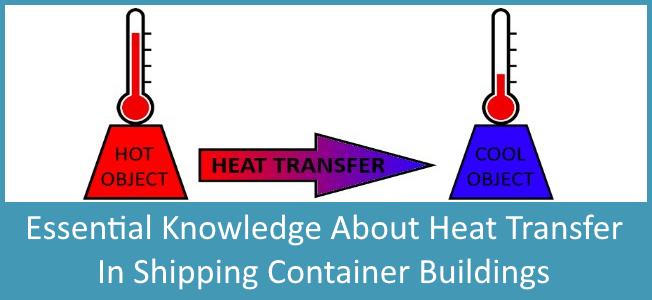

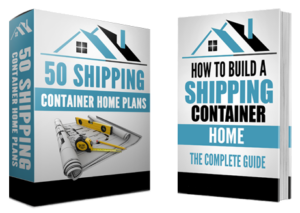
15 Responses
Bonjour
bravo
Très bons articles qui me renseignent beaucoup dans le cadre d’une maison container en cours de construction en Martinique (Caraïbes).
j’ai prévu d’isoler le toit par l’extérieur, mais aussi mettre de larges terrasses, ainsi que des écrans végétaux pour empêcher le contact direct du soleil sur les 4 containers de 40p.
Pouvez vous s’il vous plait me donner votre avis
Fred
This sounds like a nice plan. Exterior insulation often works better, if you don’t mind losing the container aesthetic on the outside of your home. You can learn more about this in some of our articles on insulation and condensation. Try to search function at the bottom of any page!
Hi, great article. I was about to begin the construction of my container home, but got some doubts concerning thermal bridging and decided to rethink my plans. I live in a very dry area, with very cold winter mornings and very hot summer afternoons. I was planning to go with 50mm polyurethane closed cell interior, and a full second roof above the house. But, no exterior insulation on the walls, and some metal walls exposed on the inside (3 containers, i mean the walls that divide containers, not the outer ones). Now im thinking those walls would be fully welded to floor and roof, and through that to exterior walls. That would be a major thermal bridge! Even if i frame those inner walls, just the thought of a huge piece of hot metal inside the house Is not very nice. Would have to isolate just as an outer wall! What do you think of this situation?
You’re right, exposed container walls on the interior of the home that have a direct metal connection to the exposed container walls on the exterior of the home can be a thermal bridge. Just how much of a bridge will depend on the length as well as the conditions of the exterior metal (wind/sun exposure, etc). It sounds like you might run the risk of seeing condensation in those early morning hours if the thermal bridge is effective enough to allow a cold spot on the interior of your home. The opposite effect, a hot spot during the hot part of the day, has less potential for damage but could also be annoying. The best answer is to try to have either the interior or exterior side of the container walls completely encapsulated by insulation. But, if you really want the exposed interior wall, a long enough thermal bridge will have lesser effects than a shorter one.
Great read, thanks.
I’m now more confused than ever. I am building a 2 level home using 10 containers in Asia. It is hot and humid most of the year. Internal heating is not required, only cooling.
I was intending to frame the inside and spray closed cell foam insulation. The outside is going to be cladded in marine ply. Is this the best option? All I really need to do is keep out the heat and moisture. Appreciate you help. John
John, it’s tough to say if that is the ‘best’ option, but it sounds like a perfectly good one. However, a lot of times, if you’re going to the trouble of externally cladding the container, you might go ahead and externally insulate as well. But if you don’t want metal walls on the interior, then you’re not really saving yourself any work. Insulating externally can give you additional room for insulation, makes it easier to deal with thermal bridging, and lets the wall breathe to the outside. If you haven’t already read it, our article on container condensation goes more into some of this: https://www.discovercontainers.com/container-condensation-prevention/
In general, condensation is less of a concern in tropical climates. Your AC unit will be doing a lot of dehumidification along with temperature cooling, so that will help with ‘keeping out the moisture’. And if you want to insulate internally, that’s perfectly fine as well.
Hi…we’re worried about condensation…does foam or polystyrene alone prevent that or do you still need a cavity ?
You need good insulation and a vapor retarder to keep warm, moist air from touching the inside of the cold container walls (assuming it’s a winter climate). Closed-cell Polyurethane Spray Foam is ideal because it also serves as a vapor retarder. With other materials, you’ll need to pay very close attention to sealing the walls. If you haven’t already, read our article on condensation for more information: https://www.discovercontainers.com/container-condensation-prevention/
Awesome article! Thanks so much!
I’m planning to build a guest-house in Sweden (kind of southish…) so my war is against cold temperatures. Regular insulation techniques here might reach a thickness of 300mm (for walls and ceiling), which in case of a 40ft container, reduces the footprint in around 7sqm (from the 27sqm approx. available). The original idea was to use “rigid” insulation panels for the walls and ceiling, but now I thinking about using 35mm “fluffy” glass wool panels and press directly against the corrugated metal (with a polyethylene film in between) to “re-gain” some centimeters. Then after this I would add the framing and the second layer of 145mm of glass wool. What do you think about the insulating material being in direct contact with the wall?
If you’re in a climate that is going to require that much insulation, it’s worth considering placing the insulation on the exterior of the container so you don’t lose so much interior space. Exterior insulation also has benefits for condensation, since the metal shell of the container will be warm (at room temperature) rather than cold (exterior temperature).
There is no real issue with having the insulation material in direct contact with the wall, this is what happens in most cases anyway. Having the polyethylene film in between could become an issue if you’re insulating the interior though. See this article for more information: https://www.discovercontainers.com/container-condensation-prevention/
I have been looking at plastic pallets to cover the outside to help with heat. I’m anxious to hear if anyone has tried this reusable option rather than insulation’s.
Pallets, whether plastic or wood, are not going to provide any insulation. What they will provide is some shade, which can help with thermal radiation. If you live in a very temperate climate where you rarely need heating or air conditioning, this MIGHT be enough, but for most people, you’ll want actual insulation. The pallets would just be a supplement.
Ready to build
Land paid off
That’s great! Good luck and keep us posted on your progress.
Trying to find my land now in Louisiana, anyone know of some land in Louisiana, let me know, or have a container home in my state let me know.